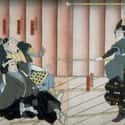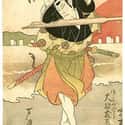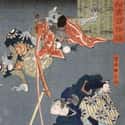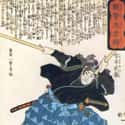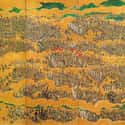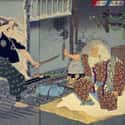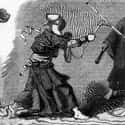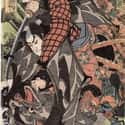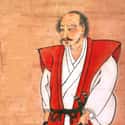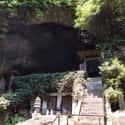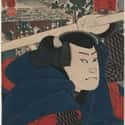-
(#1) He Beheaded A 12-Year-Old Challenger
After Musashi defeated the esteemed Yoshioka brothers, who ran a venerable kenjutsu school, the rest of the clan was infuriated. They hatched a plot that involved the new head of the clan, a 12-year-old named Matashichiro, challenging Musashi to a duel, at which the clan would ambush Musashi.
When Musashi was challenged to a night duel, he immediately became suspicious. He arrived early on the night of the duel and hid in the bushes. Sure enough, Matashichiro arrived with a retinue of battle-ready soldiers. Musashi ran out of the bush screaming, slashing off Matashichiro's head with his sword. Surrounded and outnumbered, he unsheathed a second weapon and began his defense. Despite the odds, Musashi fought his way out of the scrum. This moment is alleged to be the origin of Musashi's two-sword technique.
In A Book of Five Rings, Musashi wrote,
"The principle is 'strategy by means of the long sword'. If he attains the virtue of the long sword, one man can beat ten men. Just as one man can beat ten, so a hundred men can beat a thousand, and a thousand men can beat ten thousand. In my strategy, one man is the same as ten thousand, so this strategy is the complete warrior's craft."
-
(#2) He Was Undefeated In 60 Duels
Duels in early 17th-century Japan were often fatal. Miyamoto Musashi spent a large portion of his life traveling across Japan engaging in duels, slaughtering many master duelists along the way. Through this campaign of continual combat, Musashi perfected his skills and rose to become the greatest swordsman in Japanese history.
Not only did Musashi risk his life during his various duels, he also served in several battles. He wrote in A Book of Five Rings,
"Generally speaking, the Way of the warrior is resolute acceptance of death.
In my strategy, the training for killing enemies is by way of many contests, fighting for survival, discovering the meaning of life and death, learning the Way of the sword, judging the strength of attacks and understanding the Way of the 'edge and ridge' of the sword."
-
(#3) He Defeated A Master Swordsman With A Wooden Sword Carved From An Oar
In Musashi's most famous duel, he faced off against Sasaki Kojiro, also known as the Demon of the West. Kojiro was the ideal samurai in many ways: he was highly respected and classically trained in the Chujō-ryū school, and he was the creator and head of the Ganryū school of sword fighting. Kojiro used the longer-than-usual no-dachi two-handed sword in his technique to give himself superior range.
The duel was set for the morning of April 13, 1612, on the island of Funashima (now called Ganryū after Kojiro's famous fighting style). When the time came, however, Musashi was nowhere to be found. Kojiro and the officials sent to observe the fight were left waiting for hours. When Musashi finally arrived, intentionally late, he was disheveled and holding a bokken (a wooden sword) he had fashioned from an oar he found on the boat ride to the duel. Making opponents wait was a psychological tactic integral to Musashi's battle strategy.
Kojiro was furious about this display of disrespect. He is said to have cast aside his sheath in anger, to which Musashi responded, "If you have no more use for your sheath, you are already dead." Musashi had carved his bokken to be several inches longer than Kojiro's no-dachi, negating Kojiro's primary advantage and enabling Musashi's victory.
-
(#4) He Won His First Duel When He Was 13
While Musashi was a young man living at a Zen temple with his uncle, wandering samurai Arima Kihei came seeking challengers. Kihei, of the Shinto-Ryu school of kenjutsu, traveled from town to town issuing open challenges to anyone who would duel him. When the 13-year-old Musashi challenged him, he didn't take the boy seriously.
The next day, at the time of the duel, Musashi knocked his opponent to the ground and beat him with his wooden sword – known as a bokuto – until Kihei perished in a pool of his own blood.
-
(#5) At Age 21, He Defeated Two Sword Masters In Quick Succession
When Musashi Musashi arrived in Kyoto in 1604, he was unknown; he was determined, however, to make a name for himself. To do so, he challenged Yoshioka Seijuro of the Yoshioka Clan to a duel.
The Yoshioka clan were swordfighting teachers who had tutored members of the powerful Ashikaga clan for four generations, running one of the eight great sword schools in Kyoto. They taught using the Yoshioka Ryu style. Musashi might not have even secured a duel with them were it not for his father's reputation as a skilled swordsman.
On the morning of the duel, Musashi purposefully arrived late to anger his opponent. This strategy proved successful – Musashi won handily, breaking Seijuro's arm with his bokuto. Seijuro was so dishonored, he quit swordsmanship and became a Zen monk.
Seijuro's brother, Yoshioka Denshichiro, challenged Musashi to a duel to restore his clan's honor; as such, the duel was to be fatal. Again, Musashi arrived late. Using a bokuto, he ended Denshichiro with a single blow to the head.
-
(#6) He Swore Off War After The Second Massive Battle At The Castle Of Osaka
In 1614, Tokugawa Ieyasu was effectively the ruler of Japan. His son was shogun – a hereditary commander-in-chief – though Ieyasu was pulling the strings. There was only one potential rival to his hegemony: the son of the previous leader of Japan, Toyotomi Hideyori. Hideyori's father, Hideyoshi, unified Japan and even invaded Korea. Upon Hideyoshi's end, Hideyori was slotted to take his place. Tokugawa Ieyasu prevented this, but Hideyori's existence still posed a problem.
In the winter of 1614, Ieyasu marched 200,000 men to surround Hideyori's stronghold at Osaka Castle. Even with overwhelming numbers, Ieyasu was unable to take the castlel; he did, however, persuade Hideyori to sign a treaty ending the fight. Ieyasu reneged in the summer of 1615 and besieged the castle again. This time, weakened and partially disarmed by the treaty, the castle fell.
Musashi fought in both the winter and summer battles, though historians disagree on which side. Some claim he fought the winter battle on the side of the Toyotomi Hideyori and the summer battle on the side of the Tokugawa Ieyasu. Afterward, Musashi decided to never kill again.
-
(#7) He Invented His Own Two-Sword Technique
Unlike most famous duelists of the time, Musashi Miyamoto was not classically trained in a sword school. Instead, he developed his own technique, honing his skills with daily practice.
The Niten Ichi Ryu school of kenjutsu developed by Musashi utilizes both katana (long) and wakizashi (short) swords that samurai typically carried with them. Wielding these swords simultaneously was revolutionary at the time. Musashi believed using two hands to hold a sword, as was the common practice, to be cumbersome. The technique also placed one at a disadvantage in certain situations, such as battles performed on horseback.
Thus, Musashi believed samurai should wield a sword in one hand for increased fluidity of motion. Logically, the other hand could then be used to wield the second sword. This technique is still taught in Japan today. The school traces its lineage to Musashi through his direct pupils.
-
(#8) He Fought Against – And Defeated – Masters Of Every Weapon
Musashi didn't just fight swordsmen in duels; he purposefully sought out masters of every weapon. In 1607, he sought out an undefeated master of the kusarigama (sickle and chain) named Shishido Baiken. According to legend, Baiken struck first with the chain, dulling and bending Musashi's blade. As the two drew close to one another, Musashi pulled out his short sword, usually only used in ritual suicide. Baiken hesitated, providing Musashi with the opportunity to drive the short sword into Baiken. With his last breath Baiken whispered, "Thank you."
Later that same year, Musashi defeated Muso Gonnosuke who was a master of jojutsu (a short staff technique). At the time, Gonnosuke had allegedly never lost a duel. Since the two agreed to battle with wooden swords, Gonnosuke survived, despite his defeat. Gonnosuke spent years training for a rematch, only for Musashi to win again.
In A Book of Five Rings, Musashi wrote, "You should not have a favorite weapon. To become over-familiar with one weapon is as much a fault as not knowing it sufficiently well."
-
(#9) He Spent Years Wandering As A Shugyosha
When Musashi was a teenager, he left his hometown to trek around Japan. His samurai journey, called musha shugyō, saw him wandering the wilderness training, dueling those he could challenge, and living a taxing, minimalist lifestyle. Becoming a homeless vagrant was a common way to develop a name for yourself as a samurai, and often landed warriors employment. Life as a shugyosha wasn't easy, but it helped Musashi become a fierce warrior.
In A Book of Five Rings, Musashi wrote, “Do not sleep under a roof. Carry no money or food. Go alone to places frightening to the common brand of men. Become a criminal of purpose. Be put in jail, and extricate yourself by your own wisdom.”
-
(#10) He Died With His Sword In Hand
At 61 or 62, after completing A Book of Five Rings, finishing the Dokkodo, and suffering from neuralgia – a painful nerve disorder – Musashi knew he was dying. He summoned the monks he was staying with in the monastery near Reigando, pulled himself up onto one knee and, holding his sword in one hand and cane in the other, died like a true samurai warrior.
Many believe his cause of death to be thoracic cancer. He was buried standing and dressed in full samurai body armor.
-
(#11) A Manga Based On His Life Sold 82 Million Copies
To say Musashi Miyamoto is popular in Japanese culture is an understatement. One of the few railway stations in Japan named after a person is Miyamoto Musashi Station, near Musashi's birthplace. A Book of Five Rings is still read by martial artists, executives, and civilians alike. In the 1930s, Eiji Yoshikawa's fictional novel Musashi was so popular, people mistook it for a historical account. The serialized manga based on the novel, named Vagabond, has sold more than 82 million copies worldwide.
The most popular Musashi-related work (aside from his own writings) is probably the 1950s Samurai Trilogy staring Toshiro Mifune. The three films follow Musashi's life and memorable duels. They are only partially historically accurate, but they still provide a fascinating insight into Musashi's legacy.
-
(#12) He Fought In The Epochal Battle Of Sekigahara
In October, 1600, Japan was at a crossroads. The man who had unified much of the island under one banner, Toyotomi Hideyoshi, perished in 1598. The resulting struggle for succession was decided in a battle in the valley of Sekigahara between Ishida Mitsunari and his forces – claiming to represent the interests of Hideyoshi's young son, Hideyori – and noted general and former ally of Hideyoshi, Tokugawa Ieyasu.
Despite being outnumbered 80,000 to 74,000, Tokugawa's forces won the day when one of Ishida's allies defected. Ishida was driven into the mountains and slaughtred several days later. The decisive victory marked the end of the Sekigahara period and the beginning of the Tokugawa Shogunate.
Musashi was one of many shugyosha who fought in order to make a name for himself. Unfortunately, he fought for the side of Ishida. He did, however, survive, and he went on to fight more battles and duels. While he didn't gain renown in battle, he did gain valuable experience that would help him become Japan's greatest swordsman.
-
(#13) He Wrote A Book Of Five Rings In A Mountain Cave Near A Zen Monastery
After suffering an attack of neuralgia, Musashi sensed his life was nearing its end. In 1643, he retired to Reigando, a mountian cave near Kumamoto (far to the south of Japan, near Nagasaki). The cave was part of a Zen monastery, where Musashi went to sit in contemplation and pen A Book of Five Rings, as well as the shorter Dokkodo (The Way of Walking Alone).
A Book of Five Rings is a treatise not only on swordsmanship but on strategy and philosophy. It can be thought of as an outline of the path to enlightenment by the way of strategy, as phrased by Musashi. The book is divided into five sections, reflecting five elements: earth, water, fire, wind, and void. The book intertwines practical advice with Zen philosophy and is still highly regarded in the 21st century.
In his book, Musashi wrote,
"When I reached thirty I looked back on my past. The previous victories were not due to my having mastered strategy. Perhaps it was natural ability, or the order of heaven, or that other schools' strategy was inferior. After that, I studied morning and evening searching for the principle, and came to realize the Way of strategy when I was fifty."
-
(#14) He Left Home At A Young Age To Live With His Uncle, A Buddhist Monk
In 1584, Shinmen Musashi was born in Miyamoto village to a samurai family. His mother perished during childbirth, and his father, Shinmen Munisai, was an expert swordsman and served as Musashi's first teacher. Munisai was harsh and strict, especially toward his young son.
When Musashi was either nine or ten, he went to live with his uncle. Some accounts claim his father abandoned him, while others say he was killed in a duel. Some think Musashi simply ran away. In any case, Musashi took little else from his father but his name and the basic techniques of the samurai.
Musashi's uncle Dorin was a monk from the Shoreian temple in Miyamoto. At the temple, Musashi learned Zen Buddhism, reading, and writing. He continued to hone his swordsmanship until he left the temple to become a shugyosha (wandering samurai in training) at some point between the ages of 16 and 20.
New Random Displays Display All By Ranking
About This Tool
The identity of a Japanese samurai is a hereditary heritage, not a profession. Some samurais are also very prestigious scholars, and they can also serve as civil and military administrators, clergy, painters, and aestheticians. There were many famous samurai in history, the greatest should be Musashi Miyamoto. He was a famous swordsman at the end of the Sengoku period in Japan and became famous for his superb swordsmanship and achievements.
Miyamoto Musashi lived in a turbulent historical period, but he devoted himself to the study of warfare and swordsmanship and made great achievements. The random tool shares 14 facts about the violent life of this greatest samurai.
Our data comes from Ranker, If you want to participate in the ranking of items displayed on this page, please click here.












